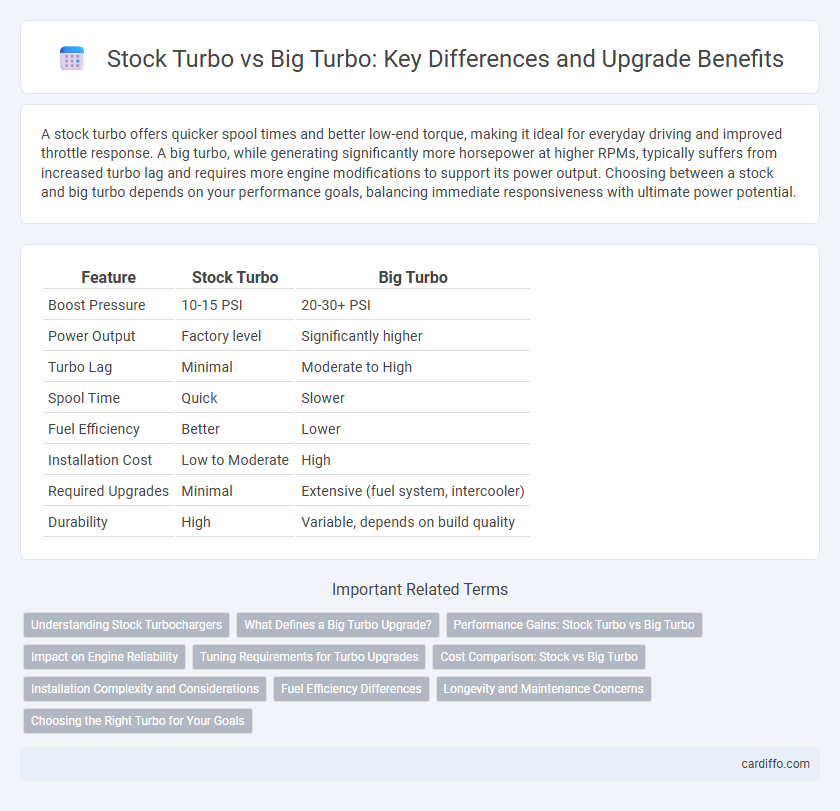A stock turbo offers quicker spool times and better low-end torque, making it ideal for everyday driving and improved throttle response. A big turbo, while generating significantly more horsepower at higher RPMs, typically suffers from increased turbo lag and requires more engine modifications to support its power output. Choosing between a stock and big turbo depends on your performance goals, balancing immediate responsiveness with ultimate power potential.
Table of Comparison
| Feature | Stock Turbo | Big Turbo |
|---|---|---|
| Boost Pressure | 10-15 PSI | 20-30+ PSI |
| Power Output | Factory level | Significantly higher |
| Turbo Lag | Minimal | Moderate to High |
| Spool Time | Quick | Slower |
| Fuel Efficiency | Better | Lower |
| Installation Cost | Low to Moderate | High |
| Required Upgrades | Minimal | Extensive (fuel system, intercooler) |
| Durability | High | Variable, depends on build quality |
Understanding Stock Turbochargers
Stock turbochargers are designed by manufacturers to balance performance, reliability, and fuel efficiency within the original engine specifications. They operate with smaller compressor and turbine wheels, providing quicker spool-up times but limited peak boost pressure compared to big turbochargers. Understanding the operating range and thermal limits of a stock turbo is crucial before considering upgrades for higher horsepower gains.
What Defines a Big Turbo Upgrade?
A big turbo upgrade is defined by a significantly larger compressor wheel and turbine housing compared to a stock turbo, enabling increased airflow and higher boost pressure for substantial power gains. This upgrade often requires supporting modifications such as upgraded fuel injectors, intercoolers, and engine management tuning to optimize performance and maintain reliability. The primary goal of a big turbo is to achieve higher horsepower and torque at the expense of increased turbo lag compared to stock or smaller turbo setups.
Performance Gains: Stock Turbo vs Big Turbo
Stock turbochargers offer quicker spool times and improved low-end torque, making them suitable for daily driving and moderate power gains. Big turbos provide significantly higher peak power by allowing increased airflow and boost pressures, but they often result in turbo lag and reduced responsiveness at lower RPMs. Performance gains from upgrading to a big turbo are most noticeable in high-performance applications where maximum horsepower output is prioritized over immediate throttle response.
Impact on Engine Reliability
Stock turbochargers typically offer balanced boost pressure that ensures consistent engine reliability by maintaining optimal operating temperatures and reducing stress on internal components. Big turbo systems increase power output but often lead to higher exhaust gas temperatures and prolonged boost lag, which can accelerate engine wear if not properly managed with supporting modifications. Upgrading to a big turbo requires careful tuning and reinforced engine internals to preserve reliability while maximizing performance gains.
Tuning Requirements for Turbo Upgrades
Stock turbo upgrades require minimal tuning adjustments due to their OEM-oriented design, allowing for easier integration with existing engine management systems. Big turbo upgrades demand extensive tuning modifications, including fuel mapping, boost control, and intercooler efficiency calibration, to optimize performance and prevent engine damage. Proper engine management software and hardware upgrades are essential for maximizing the benefits of big turbo installations.
Cost Comparison: Stock vs Big Turbo
Stock turbochargers typically cost between $500 and $1,200, offering a budget-friendly upgrade with reliable performance for everyday driving. Big turbos, on the other hand, range from $1,500 to over $3,000, requiring higher initial investment but delivering significant power gains for competitive tuning. Installation and supporting modifications also add to the total expense, making stock turbos a cost-effective choice while big turbos demand more comprehensive financial commitment.
Installation Complexity and Considerations
Stock turbo installations typically offer lower complexity due to their compatibility with existing engine components and factory tuning, reducing the need for extensive modifications. Big turbo setups require more comprehensive changes, such as upgraded fuel systems, reinforced engine internals, and custom tuning to handle increased airflow and boost pressure. Considerations for big turbo installations include potential lag, increased heat management, and ensuring the supporting hardware matches the elevated performance demands.
Fuel Efficiency Differences
Stock turbochargers generally offer better fuel efficiency due to their smaller size and quicker spool times, which optimize boost pressure at lower RPMs. Big turbos provide increased power potential but often result in higher fuel consumption because they require more fuel to maintain richer air-fuel mixtures and delay spool onset. Choosing between stock and big turbo setups impacts fuel efficiency by balancing turbo lag, boost delivery, and engine tuning parameters.
Longevity and Maintenance Concerns
Stock turbochargers typically offer longer reliability due to their balanced design and conservative boost levels, resulting in less stress on engine components and easier maintenance. Big turbos increase power potential but generate higher heat and boost pressure, accelerating wear on internal parts and requiring more frequent servicing and upgrades to supporting systems. Choosing between stock and big turbos depends on prioritizing engine longevity and maintenance frequency versus maximum performance gains.
Choosing the Right Turbo for Your Goals
Choosing between a stock turbo and a big turbo depends largely on your performance objectives and vehicle setup. A stock turbo offers quicker spool times and better low-end response, ideal for daily driving and maintaining reliability, while a big turbo delivers significantly higher horsepower potential at the expense of increased lag and tuning complexity. Evaluating factors such as intended power output, turbo lag tolerance, engine internals, and budget ensures optimal alignment with your upgrade goals.
Stock turbo vs Big turbo Infographic

 cardiffo.com
cardiffo.com